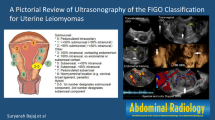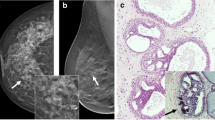Abstract
Background
One of the most important principles in modern cervical cancer surgery is the concept of tailoring surgical radicality. In practice, this means abandoning the “one-fits-all” concept in favor of tailored operations. The term “radical hysterectomy” is used to describe many different procedures, each with a different degree of radicality. Anatomic structures are subjected to artificial dissection artifacts, as well as different interpretations and nomenclatures. This study aimed to refine and standardize the principles and descriptions of the different classes of radical hysterectomy as defined in the Querleu–Morrow classification and to propose its universal applicability.
Methods
All three authors independently examined the current literature and undertook a critical assessment of the original classification. Images and pathologic slides demonstrating different types of radical hysterectomy were examined to document a consensual vision of the anatomy. The Cibula 3-D concept also was included in this update.
Results
The Querleu–Morrow classification is based on the lateral extent of resection. Four types of radical hysterectomy are described, including a limited number of subtypes when necessary. Two major objectives remain constant: excision of central tumor with clear margins and removal of any potential sites of nodal metastasis.
Conclusion
Studies evaluating radicality in the surgical management of cervical cancer should be based on precise, universally accepted descriptions. The authors’ updated classification presents standardized, universally applicable descriptions of different types of hysterectomies performed worldwide, categorized according to degree of radicality, independently of theoretical considerations.




Similar content being viewed by others
References
Landoni F, Bocciolone L, Perego P, Maneo A, Bratina G, Mangioni C. Cancer of the cervix, FIGO stages IB and IIA: patterns of local growth and paracervical extension. Int J Gynecol Cancer. 1995;5:329–34.
Kinney WK, Hodge DO, Edward V, Egorshin MD, Ballard DJ, Podratz KC. Identification of a low-risk subset of patients with stage IB invasive squamous cancer of the cervix possibly suited to less radical surgical treatment. Gynecol Oncol. 1995;57:3–6.
Querleu D, Morrow CP. Classification of radical hysterectomy. Lancet Oncol. 2008;9:297–300.
NCCN Clinical Practice Guidelines in Oncology: Cervical Cancer. Version 1 2017. Accessed 19 October 2016 at NCCN.org.
Cibula D, Abu-Rustum NR, Benedetti-Panici P, Köhler C, Raspagliesi F, Querleu D, Morrow CP. New classification system of radical hysterectomy: emphasis on a three-dimensional anatomic template for parametrial resection. Gynecol Oncol. 2011;122:264–8.
Whitmore I. Terminologia anatomica: new terminology for the new anatomist. Anat Rec. 1999;257:50–3.
Ercoli A, Delmas V, Fanfani F, Gadonneix P, Ceccaroni M, Fagotti A, et al. Terminologia Anatomica versus unofficial descriptions and nomenclature of the fasciae and ligaments of the female pelvis: a dissection-based comparative study. Am J Obstet Gynecol. 2005;193:1565–73.
Höckel M, Horn LC, Fritsch H. Association between the mesenchymal compartment of uterovaginal organogenesis and local tumor spread in stage IB-IIB cervical carcinoma: a prospective study. Lancet Oncol. 2005;6:751–6.
Fujii S, Tanakura K, Matsumura N, Higuchi T, Yura S, Mandai M, Baba T. Precise anatomy of the vesico-uterine ligament for radical hysterectomy. Gynecol Oncol. 2007;104:186–91.
Yabuki Y, Asamoto A, Hoshiba T, Nishimoto H, Satou N. A new proposal for radical hysterectomy. Gynecol Oncol. 1996;62:370–8.
Palfalvi L, Ungar L. Laterally extended parametrectomy (LEP), the technique for radical pelvic sidewall dissection: feasibility, technique, and results. Int J Gynecol Cancer. 2003;13:914–7.
Höckel M, Konerding MA, Heussel CP. Liposuction-assisted nerve-sparing extended radical hysterectomy: oncologic rationale, surgical anatomy, and feasibility study. Am J Obstet Gynecol. 1998;178:971–6.
Querleu D, Narducci F, Poulard V, Lacaze S, Occelli B, Leblanc E, Cosson M. Modified radical vaginal hysterectomy with or without laparoscopic nerve-sparing dissection: a comparative study. Gynecol Oncol. 2002;85:154–8.
Kyo S, Mizumoto Y, Takakura M, et al. Nerve-sparing abdominal radical trachelectomy: a novel concept to preserve uterine branches of pelvic nerves. Eur J Obstet Gynecol Reprod Biol. 2015;193:5–9.
Kimmig R, Aktas B, Buderath P, Rusch P, Heubner M. Intraoperative navigation in robotically assisted compartmental surgery of uterine cancer by visualisation of embryologically derived lymphatic networks with indocyanine-green (ICG). J Surg Oncol. 2016;113:554–9.
Höckel M. Laterally extended endopelvic resection: surgical treatment of infrailiac pelvic wall recurrences of gynecologic malignancies. Am J Obstet Gynecol. 1999;180:306–12.
Piver MS, Rutledge F, Smith JP. Five classes of extended hysterectomy for women with cervical cancer. Obstet Gynecol. 1974;44:265–72.
Trimbos JB. TNM-like classification of radical hysterectomy. Gynecol Oncol. 2009;113:397–8.
Benedetti-Panici P, Scambia G, Baiocchi G, Maneschi F, Greggi S, Mancuso S. Radical hysterectomy: a randomized study comparing two techniques for resection of the cardinal ligament. Gynecol Oncol. 1993;50:226–31.
Landoni F, Maneo A, Zapardiel I, Zanagnolo V, Mangioni C. Class I versus class III radical hysterectomy in stage IB1-IIA cervical cancer: a prospective randomized study. Eur J Surg Oncol. 2012;38:203–9.
Girardi F, Lichtenegger W, Tamussino K, Haas J. The importance of parametrial lymph nodes in the treatment of cervical cancer. Gynecol Oncol. 1989;34:206–11.
Benedetti-Panici P, Maneschi F, D’Andrea G, et al. Early cervical carcinoma: the natural history of lymph node involvement redefined on the basis of thorough parametrectomy and giant section study. Cancer. 2000;88:2267–74.
Acknowledgement
This study was funded in part through the NIH/NCI Support Grant P30 CA008748 (Nadeem R. Abu-Rustum).
Disclosure
Denis Querleu received travel expenses for the 2014 IGCS meeting (Melbourne) from Karl Storz GmBH. He has consulted for Roche Inc. Other authors declares no conflicts of interest.
Author information
Authors and Affiliations
Corresponding author
Electronic supplementary material
Below is the link to the electronic supplementary material.
Fig. S1
Medial paravesical space developed medial to the lateral ligament of the bladder. Supplementary material 1 (PPT 283 kb)
Fig. S2
Medial pararectal space artificially created lateral to the rectal pillar and mesorectum, medial to the autonomic nerves. Supplementary material 2 (PPT 274 kb)
Fig. S3
Medial and lateral part of the paracervix. Courtesy of Pr. Brigitte Mauroy, Institute of Anatomy, University of Lille, France. *From Querleu D, Morrow CP. Classification of radical hysterectomy. Lancet Oncol. 2008;9:297–303. Supplementary material 3 (PPT 669 kb)
Fig. S4
Resection of paracervix at the ureter. The caudal limit must not involve the inferior hypogastric plexus. Supplementary material 4 (PPT 1375 kb)
Fig. S5
Type C2 resection showing complete dissection of the ureter from ventral parametria. Supplementary material 5 (PPT 2126 kb)
Fig. S6
Type C2 resection showing medial pararectal, lateral pararectal, and lateral paravesical spaces unified by transection of pelvic attachment of the paracervix together with splanchnic nerves in the caudal part. Supplementary material 6 (PPT 326 kb)
Rights and permissions
About this article
Cite this article
Querleu, D., Cibula, D. & Abu-Rustum, N.R. 2017 Update on the Querleu–Morrow Classification of Radical Hysterectomy. Ann Surg Oncol 24, 3406–3412 (2017). https://doi.org/10.1245/s10434-017-6031-z
Received:
Published:
Issue Date:
DOI: https://doi.org/10.1245/s10434-017-6031-z




